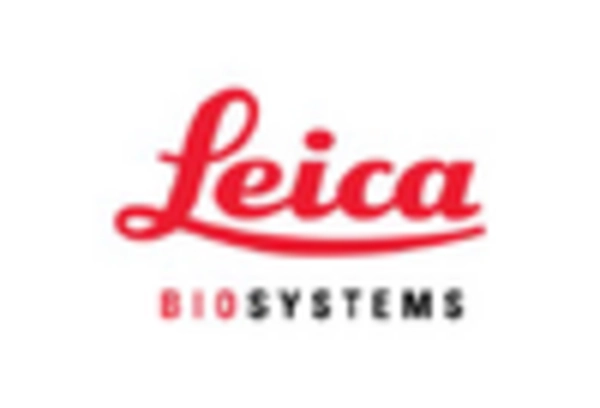Increasing Cancer Incidence
The rising incidence of cancer in the GCC region is a primary driver for the tissue microarray market. As cancer cases continue to escalate, the demand for advanced diagnostic tools, including tissue microarrays, is likely to increase. According to recent statistics, cancer rates in the GCC have shown a significant upward trend, with projections indicating a potential increase of over 20% in the next decade. This surge necessitates innovative solutions for early detection and personalized treatment strategies, thereby propelling the tissue microarray market forward. Healthcare providers are increasingly adopting these technologies to enhance diagnostic accuracy and improve patient outcomes. Consequently, the tissue microarray market is expected to witness substantial growth as healthcare systems strive to address the challenges posed by rising cancer prevalence.
Government Initiatives and Funding
Government initiatives aimed at enhancing healthcare infrastructure in the GCC are likely to bolster the tissue microarray market. Various national health programs are being implemented to promote research and development in cancer diagnostics and treatment. For instance, funding allocations for cancer research have increased, with some countries in the region committing over $100 million annually to support innovative technologies. These investments are expected to facilitate the adoption of tissue microarrays in clinical settings, thereby improving diagnostic capabilities. Furthermore, public-private partnerships are emerging, fostering collaboration between government entities and private firms to advance research in the tissue microarray market. Such initiatives not only enhance the availability of advanced diagnostic tools but also contribute to the overall growth of the healthcare sector in the GCC.
Rising Awareness of Early Diagnosis
There is a growing awareness regarding the importance of early diagnosis in the GCC, which is positively influencing the tissue microarray market. Educational campaigns and health awareness programs are being launched to inform the public about the benefits of early cancer detection. This heightened awareness is likely to lead to increased screening and diagnostic testing, thereby driving demand for tissue microarrays. As healthcare providers emphasize the significance of timely intervention, the market for tissue microarrays is expected to expand. Additionally, the integration of tissue microarrays into routine diagnostic protocols may enhance the accuracy of cancer diagnoses, further solidifying their role in the healthcare landscape. The tissue microarray market stands to benefit from this trend as more patients seek advanced diagnostic options.
Technological Integration in Healthcare
The integration of advanced technologies in healthcare is a crucial driver for the tissue microarray market. Innovations such as artificial intelligence and machine learning are being increasingly utilized to enhance the analysis of tissue microarrays. These technologies can improve the accuracy and efficiency of diagnostic processes, making them more appealing to healthcare providers. In the GCC, hospitals and research institutions are investing in state-of-the-art equipment and software to facilitate the adoption of tissue microarrays. This trend is expected to lead to a more streamlined workflow in pathology labs, ultimately increasing the demand for tissue microarrays. As the healthcare sector continues to embrace technological advancements, the tissue microarray market is likely to experience significant growth.
Collaboration Between Research Institutions
Collaboration between research institutions and healthcare providers in the GCC is fostering advancements in the tissue microarray market. Joint research initiatives are being established to explore the potential applications of tissue microarrays in various fields, including oncology and personalized medicine. These collaborations often result in the development of innovative diagnostic tools and methodologies, which can enhance the effectiveness of tissue microarrays. Furthermore, partnerships between academic institutions and industry players are likely to accelerate the translation of research findings into clinical practice. As these collaborative efforts continue to grow, the tissue microarray market is expected to benefit from increased innovation and improved product offerings, ultimately enhancing patient care in the region.

















Leave a Comment